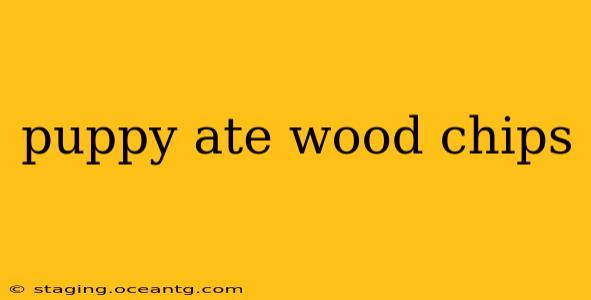Finding out your puppy has ingested wood chips can be incredibly alarming. The severity of the situation depends on several factors, including the type of wood, the amount consumed, and your puppy's size and overall health. This comprehensive guide will help you understand the risks, what to watch for, and when to seek immediate veterinary attention.
What Happens if a Puppy Eats Wood Chips?
Wood chips themselves aren't inherently toxic, but the potential dangers are significant. The main concerns are:
- Obstruction: Larger pieces of wood can cause a blockage in your puppy's digestive tract, leading to vomiting, constipation, abdominal pain, and potentially life-threatening complications. Smaller splinters can also cause irritation and damage to the intestinal lining.
- Splinters: Sharp splinters can puncture the digestive tract, causing internal bleeding and infection. This is a serious emergency requiring immediate veterinary intervention.
- Bacteria and Parasites: Wood chips can harbor bacteria, fungi, or parasites that could cause illness in your puppy.
How Much Wood is Too Much?
There's no magic number, but the more wood chips your puppy has consumed, the higher the risk of complications. Even a small amount could pose a problem, especially if the pieces are large or sharp. Consider the size of your puppy – a small breed will be more at risk from a smaller quantity than a large breed.
My puppy ate a small amount of wood chips - should I be worried?
A small amount of very small, smooth wood chips might pass through your puppy's system without incident. However, close monitoring is crucial. Watch for changes in your puppy's behavior, stool consistency, and appetite. Any signs of distress warrant a call to your veterinarian.
My puppy ate a large amount of wood chips - what should I do?
If your puppy has consumed a large amount of wood chips, especially if they are large or sharp, immediate veterinary attention is essential. This is considered a veterinary emergency. Do not attempt to induce vomiting at home without consulting your vet; this can potentially worsen the situation.
What to Do If Your Puppy Eats Wood Chips
- Remain Calm: Panicking won't help your puppy. Assess the situation calmly and take appropriate action.
- Identify the Type of Wood: Knowing the type of wood can help your vet determine the potential risks. Was it treated lumber, cedar, pine, etc.? Treated lumber contains chemicals that could be toxic.
- Check Your Puppy: Observe your puppy carefully for signs of distress, such as vomiting, diarrhea, lethargy, loss of appetite, abdominal pain, or straining to defecate.
- Contact Your Veterinarian: Even if your puppy seems fine, it’s crucial to contact your vet. They can advise you based on the specifics of the situation and your puppy's age, breed, and size.
- Gather Information: Be prepared to tell your vet the type of wood, the estimated amount your puppy ate, and the time of ingestion.
- Follow Veterinary Instructions: Your vet will provide guidance on the best course of action, which may include monitoring at home, X-rays, or more involved treatment.
Preventing Future Incidents
- Secure Hazardous Materials: Keep all potential hazards, including wood chips, out of your puppy's reach.
- Puppy-Proof Your Home: Regularly check your home for potential dangers and make necessary adjustments to ensure your puppy's safety.
- Supervise Your Puppy: Close supervision is essential, especially during playtime.
This information is for general knowledge and does not replace professional veterinary advice. Always consult your veterinarian for any concerns about your puppy's health. Early intervention is key to a positive outcome in cases of wood chip ingestion.
